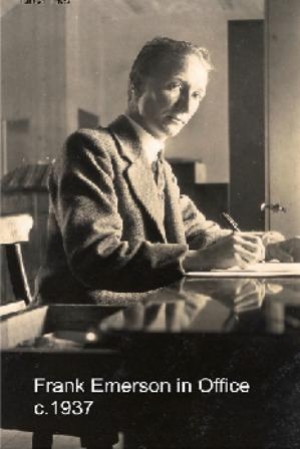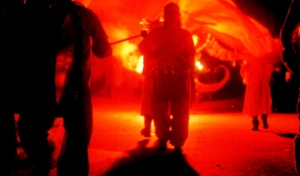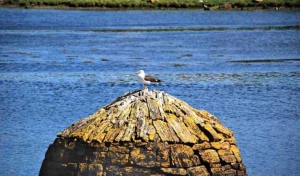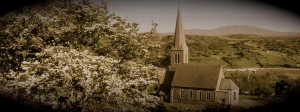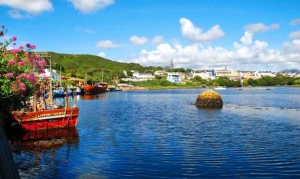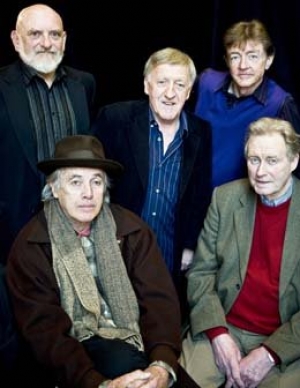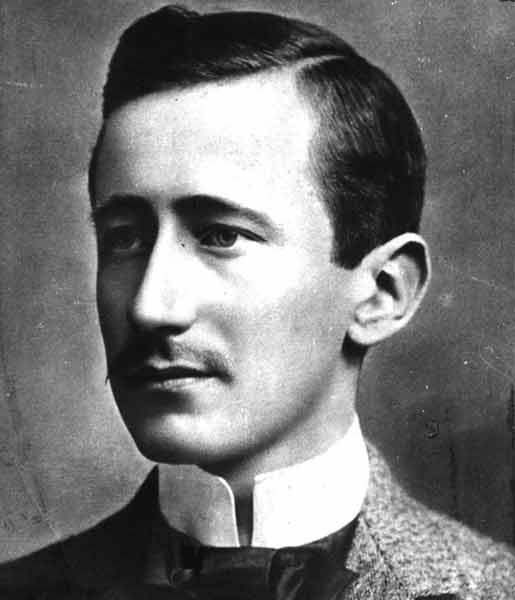Clifden 2012 Team
Website URL: E-mail: This e-mail address is being protected from spambots. You need JavaScript enabled to view it
Just published!
This booklet celebrates Clifden's 200 year past featuring a fascinating mix of articles on wide range of topics of both local and international importance, along with some early period photos of the town. The booklet also features a programme of events that are taking place throughout the year.
View the book online.
Click on the book cover below to expand it to a full screen view.
The Emerson and O’Brien Families & their part in the Early History of Clifden
O’Brien Family
Michael O’Brien (1791-1871) set up a Classical School in the townland of Ardbear, just outside Clifden, at the junction of Roundstone Road and the lane leading to the Rugby pitch. Michael was a Classical Scholar from Ennistymon, County Clare, and a cousin of Lord Inchaquin of Dromoland Castle.
Michael married Anne Smith (1804-1898) from Oughterard, Co Galway, circa 1825. According to the Parish of Omey records, the O’Brien’s lived in Post Office Street, (Seaview), Clifden, in 1855. Michael and Anne had seven children, all very well educated for the time; John, Lucius, Mary, Honora, Ellen, Michael, and Charles O’Brien.
The O’Brien’s eldest son, John, born in Clifden circa 1827, emigrated to Melbourne, Australia. Letters home, still held in the house in Seaview, show that, because of his Classical Education in Clifden, by 1853 John had become Inspector of Schools for Melbourne.
The second son, Lucius (c.1829-c.1907), went to New York, where he was robbed of his money, and joined the Army as a common soldier. As this was infra dig for a Gentleman, he used the false name of Lucius Smith. He was commissioned to the rank of Captain in the Field during the American Civil War, became a career soldier in an Artillery Regiment, and retired as a Colonel, under the Army approved name of Lucius Smith O’Brien.
The O’Brien’s eldest daughter, Mary O’Brien, born circa 1833, married William Neyland (1830-1870) in Clifden. On the death of her husband, Mary emigrated to Boston in 1871 along with her eight children, where she remarried and had two more children.
The O’Brien’s youngest daughter, Ellen (1838-1919), met and married a builder from Clare, Thomas Emerson. They were married in Clifden in 1855 when Ellen was 17 years of age.
Emerson Family
The Emerson Family traces it history back to William Emerson (c.1600-c.1650) who came from Bedfordshire in England to Corofin, County Clare, circa 1630, and settled there before the time of the Cromwellion Plantations.
Thomas (Tom) Emerson (1831-1902) [Ellen O’Brien’s husband] came from Corofin, County Clare. His father, John Emerson (c.1795-c.1860), was a builder in Corofin, where he lived with his wife Mary Dickson, and where they had at least five children.
Although a Catholic, Tom had been baptised in the Church of Ireland in Corofin, and as a builder he did most of his work for Church of Ireland clients. At that time it was not always possible to have the birth and baptism registered in the Catholic Church, as Catholic Churches were very few in number. It was also the norm at that time for the sons to be brought up in the father’s religion, and the daughters in the mother’s religion.
Tom set up as a builder in Clifden circa 1852. He married Ellen O’Brien in 1855 and they had ten children; Annie, Michael, Mary, John, Henrietta, Susan, Thomas, Nora, Kathleen, and Charles.
Tom had a brother John (1824-1912), who was also a builder and had worked on the restoration and remodelling of Ashford Castle. Tom and John had arranged for John’s eldest son, Geoffrey Roberts Emerson, to go to Clifden and to marry Tom’s eldest daughter, Annie.
However, when Geoffrey Roberts met Tom’s six daughters in Clifden he fell in love with the second daughter, Mary, and married her instead in 1882 when she was 19 years of age.
Geoffrey Roberts Emerson (1855-1919)
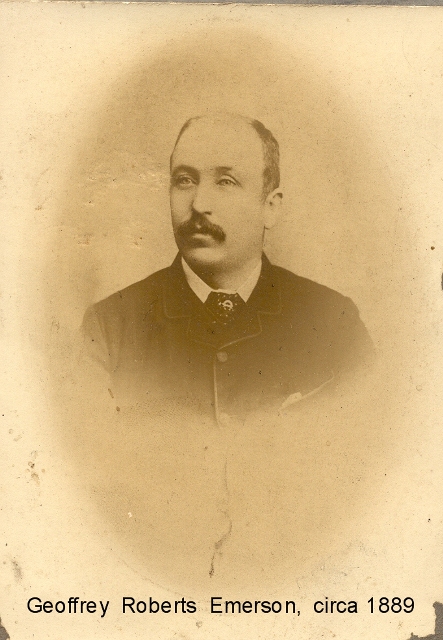
Geoffrey Roberts and his wife Mary Emerson (1863-1943), known as “The Mater”, lived first in Nollie Lee’s house on the hill in Market Street, but later lived in Roundstone for five or six years in the late 1800’s.
While living in Roundstone Geoffrey R. built the Estate House in 1895, now extended and known as Cashel House Hotel and presently owned by his granddaughter, Kay Emerson McEvilly. This house and its gardens were to his own design and were considered particularly good. Geoffrey R. also built Cashel Church and a number of other Estate Houses in the Roundstone Parish area.
On returning to Clifden in the early 1900’s, Geoffrey R. and Mary purchased “The Ivy” at the Waterfall, as their home. “The Ivy” was said to have been built by the original builder who built Clifden Castle, and this may well be true.
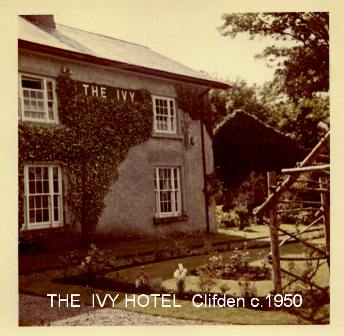
Geoffrey R. built a number of houses, rebuilt others, and carried out maintenance work on the Convent of Mercy School and orphanage in Clifden in the early 1900’s. Brian Mahon’s Terrace, next to the Clifden workhouse, was built for soldiers who had survived the First World War and its construction was supervised by Geoffrey R.
Geoffrey R. and his wife Mary, ‘The Mater’, had seven sons and two daughters, Jack, Ray (short for Geoffrey), Thomas, Mary Josephine (Moddie), Timothy, Leticia, Louis, Francis Joseph (Frank), and Sydney. Most of their sons worked as builders; Tom in Melbourne, Australia, Ray and Louis in New York, and Timothy (Marie Emerson Brennan’s father) in Clifden.
After Geoffrey R. died in 1921, ‘The Mater’ and her daughter, Moddie Emerson, established The Ivy Hotel and ran it as a hotel for many years. The first Motor Car to come to Clifden was owned by a Dr. Petherbridge, a Botanist from London University , who stayed (circa 1920+) in The Ivy Hotel when he came on his regular visits to the area to study fauna in the bogland between Clifden and Roundstone Hill.
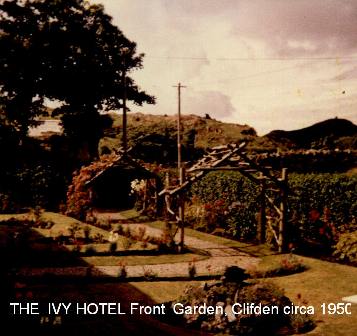
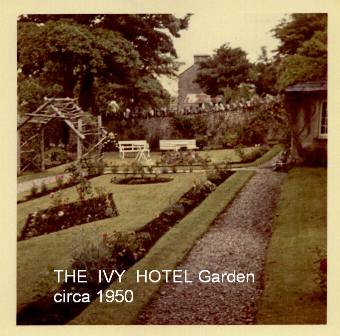
Timothy Emerson (Timmy) (1889-1975)
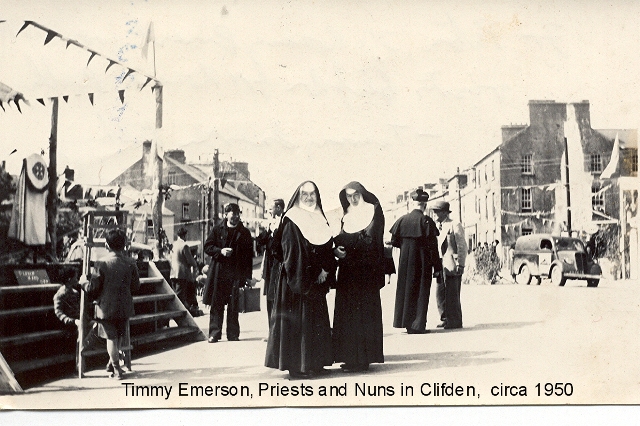
Geoffrey R.’s fourth son, Timothy Emerson (Timmy), took over his father’s Design and Building Practice in Clifden and lived with his wife, Annie Barry, in the house in Seaview that was originally owned by his great grandfather, Michael O’Brien. Timmy restored and renovated the house in the Nineteen Thirties, and his daughter, Marie Emerson Brennan, continues to live there today.
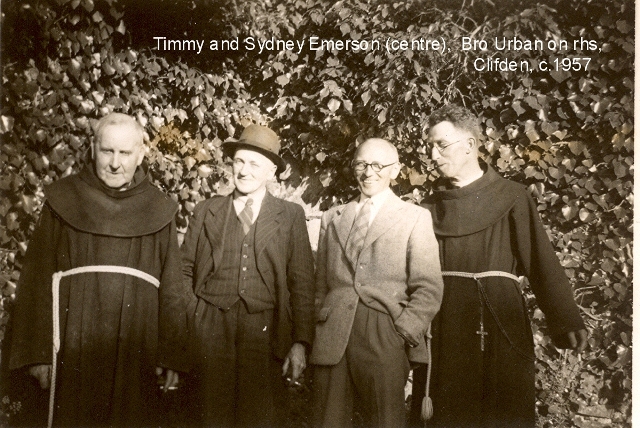
Frank Emerson (1901-1978)
Frank Emerson, the sixth son of Geoffrey R. and ‘The Mater’, was the Manager of the Employment Exchange in Clifden for many years. The area he serviced included most of Connemara and the islands, and he claimed it was the largest Employment Exchange area in the country. As a boy Frank witnessed the spectacular arrival of Halley’s Comet in May 1910. This comet returns to our Solar System every 76 years, but its next visit in 1986 was far less spectacular due to cloudy conditions. On the 15th June 1919 he watched the Alcock and Brown plane circling Clifden after its flight from America, looking for a place to land before it landed in the bog where he inspected it later that day near the Marconi Station which he frequently visited.
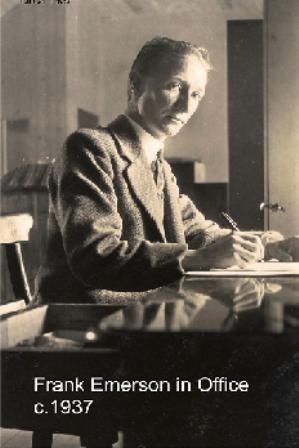
Frank’s son, Geoffrey J. Emerson, and his grandson, Geoff Emerson, carry on the family tradition. Both are Civil Engineers and work as Consulting Engineers in the company of Clifton Scannell Emerson Associates in Blackrock, County Dublin, and have been responsible for construction projects throughout Ireland.
Charles Emerson (1878-1921)
Charles Emerson was the youngest brother of Mary Emerson (The Mater) and a son of Thomas Emerson and Ellen O’Brien. Charles became Head Master of Monaghan Vocational School, and was a Commandant in the Old IRA. He died in Clifden in 1921, after his release from Belfast Jail, as a result of a hunger strike there in which he had participated. A huge Military funeral of five Companies escorted his remains to the Emerson plot in Ardbear Cemetery, Clifden, and was described in detail in the Connaught Tribune at the time.
Note: Most of the above named persons are buried in Ardbear Cemetery and are named on the family Headstones.
Family History & photographs courtesy of Geoffrey Emerson
An Early Tour Guide to Clifden
The following excerpt is taken from ‘Picturesque Ireland’ by John Savage, a well known Dublin born Fenian poet, journalist and author who emigrated to America in 1848. The work was first published in 1856; the version reproduced here is taken from an edition by Thomas Kelly Publishers of New York in 1877.
‘Picturesque Ireland’ is described as ‘a literary and artistic delineation of the natural scenery, remarkable places, historical antiquities, public buildings, ancient abbeys, towers, castles, and other romantic and attractive features of Ireland’.
Essentially, it was a handbook or travel guide to Ireland for the educated tourists of the time, published in the United States.
It paints a vivid and attractive picture of mid 19th century Clifden and the Connemara region for the reader, complete with illustrations.

“Clifden can be reached, as intimated, from Roundstone, or, returning by Lough Ballinahinch, the more picturesque route can be resumed. After leaving the lough, a road to the right leads to the green-marble quarries, where a finely streaked calcareous serpentine mottled stone with various shades of green and white is found. It is specially adapted for ornamental columns and mantels, and is worked into other forms, brooches, crosses, etc. as souvenirs of a Connemara excursion. The ride from Ballinahinch to Clifden is “surprisingly beautiful!” and, to use again the words of Thackeray, there are views of the lake the surrounding country, which, in his opinion, were not surpassed by the best parts of Killarney, “although the Connemara lakes do not possess the advantage of wood, which belongs to the famous Kerry landscape.”
Clifden is romantically situated on a height at the head of and overlooking the harbour of Ardbear, an inlet of Clifden Bay; while on the other side it is overtopped by the mountains which form a splendid amphitheater in the background. “It has arisen something after the fashion of an American town,” says a writer; because in 1815, it had but one house, and in the course of forty years it could boast of having four hundred houses. Although a stretch of fancy to compare this growth with that of “an American town” it was a matter of historical and no ordinary gratification in Ireland. It was founded by Mr. D’Arcy, one of the great proprietors. He pointed out the advantages which would accrue to this remote neighbourhood of having a town and a sea-port so situated; and he offered leases forever, of a plot of ground for building, together with four acres of mountain land, at but a short distance from the proposed site of the town, at twenty-five shillings – about six dollars – per annum. This offer was most advantageous, even leaving out of account the benefit which would necessarily be conferred by a town in a district where the common necessaries of life had to be purchased thirty miles distant; and where there was no market, and no means of export for agricultural produce; and so the town of Clifden was founded and grew.
But if the town flourished, the founder did not. The D’Arcys “have been reduced by their liberality,” and, like the Martins, were sold out under the Incumbered Estates Act. The views of Clifden from the eminences around it are singularly attractive. The Owenglen River rushing down from Bennabola forms a fine waterfall close to the town; and the prison perched upon the rocky summit of a hill overlooking it, gives, says Black’s Guide, “in the distance, the idea of the Castle of Edinburgh.” We may, perhaps, agree with Hall, that the castellated form crowning a hill which rises between the Waterfall and the town presents a somewhat Spanish appearance. The waterfall is, without doubt, remarkably picturesque, and a very attractive feature of Clifden. The tumult of its cascades is heard amid the vivacity of the commerce of the prosperous town: “the rush of waters mingles with the voices of its inhabitants; yet, turning from the houses, it seems as lonely in its grandeur, as if in the center of the untrodden hills”. Rapidly flowing down from the Twelve Pins, the stream passing under an old-fashioned triple-arched bridge, which adds to the pictorial effect, suddenly turns at a right angle and leaps and shoots through a mass of rocks with very brilliant and fascinating effect. Reaching the bottom it takes another sudden turn, and dashes under another bridge, which spans its rocky borders, to join the Atlantic.
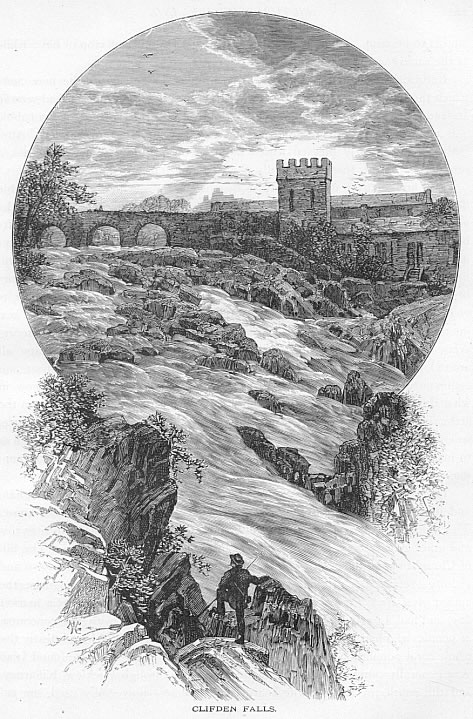
Nowhere is the facility for improving certain description of bog-lands more plainly and happily demonstrated than in the neighborhood of Clifden. Fine crops of grass, potatoes, and various kinds of grain are seen luxuriantly growing on land that was, not long in the past, only used for turf-cutting. As a harbour and sea-port, Clifden has important advantages; possessing deep water in the bay and safe anchorage for vessels of any burden. Many nautical men consider it the best harbor on the west coast for large vessels, and ships of war, when on service in the Atlantic, frequent it, where they ride out the fiercest gales in perfect security.
Clifden Castle, built by the former proprietor of the district and occupied by his successor Mr. Eyre, is less than two miles distant, beautifully situated on the shores of Ardbear Harbor, adorned with thriving plantations and grassy lawns, and commanding an extensive view south and east. A path, open to the public, runs along the bank of the bay from the town to the demesne, and affords the tourist a delightful walk. Willis thought these two miles “one of the most beautiful walks in Ireland;” and Inglis peremptorily says, “let no traveller be in this neighborhood without visiting Clifden Castle”. He is enthusiastic on the pleasure of this promenade, and his appreciation was enhanced by certain poetic surroundings of time and weather. “The walk from Clifden,” he writes, “by the water side, is perfectly lovely: and the distance not greater than two miles. The path runs close by the brink of a long narrow inlet of the sea, the banks of which on both sides, are rugged and precipitous. It was an evening of extraordinary beauty when I sauntered down this path; the tide was full, and the inlet brimful and calm; and beyond the narrow entrance of the bay lay in almost as glassy a calm, though with a gentle heaving, the wide waters of the Atlantic.
After reaching the entrance of the bay, and rounding a little promontory, Clifden Castle comes into view. It is a modern castellated house; not remarkable in itself, but in point of situation unrivaled. Mountain and wood rise behind; and a fine sloping lawn in front, reaches down to the beautiful land-locked bay; while to the right, the eye ranges over the oceans, until it mingles with the far and dim horizon. Twenty years ago, the whole of this was bog, now not a rood of bogland is to be seen. The lawn I saw laden with a magnificent crop of hay; while at the same time, the sunk fence showed a deep bog.”
Returning by the mountain road he was again delighted with the new views which this route disclosed, more Swiss in character than anything he had seen in Ireland. “The mountain range behind Clifden – the Twelve Pins of Bennabola – is always worthy of Switzerland. In its outline, nothing can be finer. Altogether I was greatly pleased with Clifden; and I think I may safely risk a prophecy, that this town will rapidly rise into importance.”
The first quarter of a century of its existence was a period of remarkable development, and if the succeeding period has not been as enterprising in the same ratio it was because of the slow rate of improvement in the interior. Its beauty and advantages are universally acknowledged, and Sir John Forbes pays it an additional recognition which, coming from a distinguished physician, will not be overlooked by invalids. After paying respect to “the majestic summits of the ever-charming Bennabola,” he continues: “From the high grounds in its vicinity there is a full view of the Atlantic; as well as of the innumerable seas-inlets that break through and inclasp the land on all sides with their glittering arms. There is indeed, something singularly pleasing in the landscape all around, particularly in that hilly ridge which looks along the Bay of Ardbear, and commands the view of the wide Atlantic beyond it. Although I hardly know in what the charm consists, I have certainly seen no spot in Ireland, which, from the attractiveness of mere locality, would claim my suffrage, as a place of residence, so entirely as Clifden. Over and above its scenic beauties, its position is such as to insure for it every terrestrial and climatorial condition that is found most conducive to health.”
The tract on which Clifden stands was formerly called Clochan or Cloughan, and it is still so called in the Irish, which means a beehive-shaped stone house. The modern is a corruption of the old name, the ch being changed to f, in this and other names of places, illustrations of which are given by Joyce. The hill of Cloughan-ard—the ascent of which is recommended for views of the town and vicinity—retains the original name. In connection with the old language, the author of A Run Through the West of Ireland who was in Clifden on a market day, and had a good opportunity of observing and speaking with the concourse of people who had all sorts of commodities for sale, says, “We found nearly the whole rural population speaking Irish. Throughout all our route we found Irish very generally spoken, and as in our previous tours through Wicklow, Killarney, and the south, my English wife heard English almost universally used, she entertained the notion that the Irish language had completely died out. This was removed by her trip to Connemara.”
Thanks to Gerritt Nuckton for transcription.
Connemara Genealogy Guide Launched
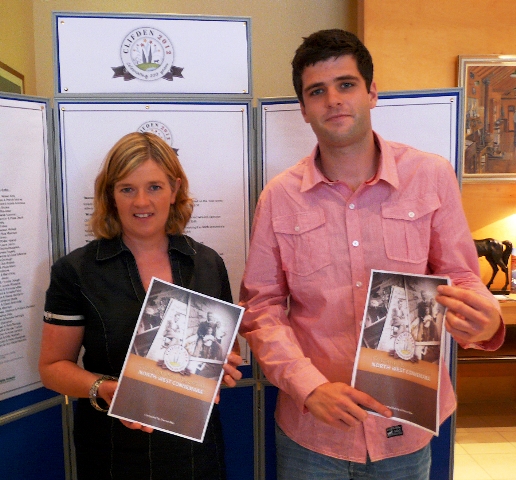
Galway County Heritage Officer Marie Mannion, who launched the local Genealogy Guide 'Tracing Your Family Roots in North-West Connemara' in August 2011 with author and compiler Steven Nee.
A new local genealogy guide, the first of its kind in Connemara, has been launched in Clifden in a bid to encourage people to research their ancestry in the region on the West Coast of Ireland. The town of Clifden will celebrate 200 years since its founding by the enterprising John D’Arcy next year in 2012, and a dedicated local voluntary committee is busy at work planning a year-long series of heritage and history events to mark the anniversary.
‘Tracing Your Roots in North West Connemara’ was compiled and written by Ballyconneely native Steven Nee, who is a graduate of Heritage Studies and also holds an MA in Business. It offers a step by step guide to undertaking your own research into your family tree, with tips and hints particular to the Connemara region. The guide is aimed at anyone, anywhere in the world who would like to research their Connemara roots, and is available now as a downloadable booklet on the website www.clifden2012.org. If used through the website, you can click through directly to the relevant links online, or alternatively it can also be printed off and kept as a guide on an ongoing basis.
This guide focuses particularly on the parishes of Ballindoon, Ballynakill, Moyrus and Omey. It includes descriptions and explanations of the relevant administrative divisions, townlands and maps and the diverse range of records and sources that are available relating to these areas, including the 1901 and 1911 census and Griffith’s Valuation.
‘Tracing Your Roots in North West Connemara’ was funded by Forum Connemara and the LEADER project and also supported by Galway County Council and it is one of the key elements of next year’s Clifden 2012 events in genealogical terms. The Clifden 2012 group’s hope is that the guide will become an invaluable resource to individuals both at home and overseas, whose ancestry is here in Connemara. A comprehensive genealogical seminar will form a significant part of The Clifden 200 Festival which will take place from May 25th-June 4th, and it is anticipated already that there will be significant interest and attendance from overseas.
For more information on Clifden 2012 see www.clifden2012.org or contact Catherine Pryce at This e-mail address is being protected from spambots. You need JavaScript enabled to view it . ‘Tracing Your Roots in North West Connemara’ is now available to download free of charge from the www.clifden2012.org homepage.
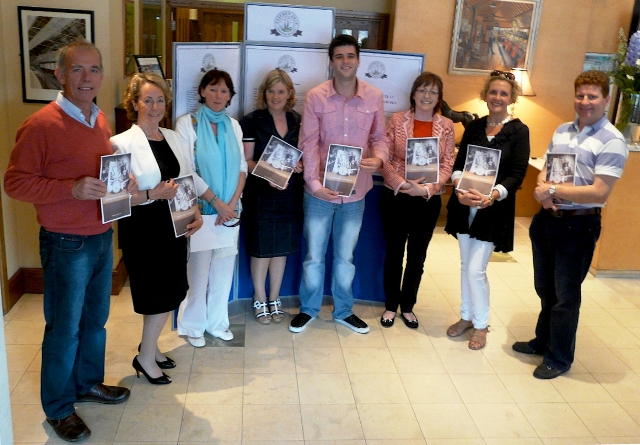
Pictured at the launch of 'Tracing Your Roots in North West Connemara were (l-r): Clifden 2012 Committee members Charlie Bourke, Kathleen Villiers-Tuthill and Sheila Griffin, Galway County Heritage Officer Marie Mannion, Author Steven Nee, Karen Mannion of Forum Connemara Ltd and Clifden 2012 committee members Michele Hehir and Declan Mannion.
Why should I donate?
Be a part of creating a lasting legacy for future generations
Inform and engage current generations
Reconnect with your ancestral home, or long lost neighbours, friends & relatives
Help to provide a fun filled festival atmosphere in Clifden throughout 2012
Financial support from the international community will allow us to access more funding from established sources here in Ireland
Your online donation will be securely processed by PayPal. None of your information will be retained after your donation has been received
Your personal support will ensure that Clifden's 200th birthday celebrations will live long in the memories of all involved, while revitalising and uniting our diverse and unique Irish community.
Becoming a Friend of 2012
A donation of €200 (or currency equivalent) will make you one of 200 'Friends of Clifden 2012'. Friends of Clifden 2012 will receive honourable mention here on the website and in our printed programmes throughout the year, a scroll of appreciation and a commemorative pin.
The Friends of Clifden 2012 are the fundamental group upon which the success of the year's events will be built, so please pledge your support-it will be very much appreciated! ($285 US dollars, £175 GBP, $270 AUD)
All donations towards this ambitious community event, of any amount, are highly appreciated and valued, and will go towards ensuring a great year for Clifden in 2012.We hope to see you there!
Standing Order Form
You can also pay by Standing Order - download our Standing Order form here:
![]() Standing Order Form (587.5 kB)
Standing Order Form (587.5 kB)
Donate now and help Clifden celebrate it's 200th birthday!
The State of the Irish Fisheries in 1836
The quay of Clifden is near the eastern extremity of Ardbear Bay, contiguous to the village, and on the estate of Mr. John D'Arcy. Clifden is not a place of rendezvous from whence boats proceed to the fishing grounds, being too far embayed; but its utility consists in affording a safe landing-place, and a certain market for fish to any amount, and in supplying all necessaries for the outfit of the fishery and merchandise for the country in general; there being extensive stores erected on the quay for the curing of fish. And the supply of the necessaries mentioned above. The village is entirely a new creation, and owes its rise to the establishment of the Harbour, and opening the country by the Government roads that have been made.
The plan which was given by Mr. Nimmo consists of a Boat and slip quay, five hundred and eighty nine feet in length, with an elbow or obtuse turn along a cliff three hundred feet in length, for shipping of deep craft, but only one hundred and seventy five feet of the ship quay is finished, and three hundred and fourteen feet in length of the boat quay has been raised within two feet of its intended height. Sixty seven feet of the ship quay, the entire three hundred feet of the elbow or deep ship quay and two feet in height of the boat quay remain undone. Under the contract this work should have been completed on or before the 1st day of August 1823.
In 1822 the Board granted £228 9s 2d towards the expense of this work, including the cost of erecting a breakwater at Doughbeg, about a mile westward of Clifden; the amount of the estimate of the whole being £456 18s 5d; in addition to which, the Board supplied machinery to the value of £34 19s, and contracted Mr. D'Arcy, who undertook to contribute £288 9s 3d for the executions.
The Board agreed to pay Mr. D'Arcy in instalments, as certain portions of the work would be certified by the Boards engineer to have been duly executed; under which clause Mr. D'Arcy received payments amounting to £168 16s, including the value of machinery, and £94 12s 2d now stands to the credit of the work.
It may be proper to observe, that £342 9s 1 and a ½ d (Irish) is charged to Government as expended on this work, exclusive of the foregoing sums.
It is obvious that the work was inadequate to the expense of executing such extensive works, and believing it was not probable they would be completed without the Board's interference, in November last I recommended that the balance standing to the credit should be expended in completing, so far as adequate, which would secure and finish as much of this interesting Harbour as would be at all necessary for fishery objects, and I now respectfully repeat that recommendation.
This Harbour may be placed in the second class for its utility in promoting the fishery.
The breakwater at Doughbeg was included in the foregoing estimate, though a distinct and detached work. It was finished, and is a useful work; it stands in need of some trifling repairs, but the damage being the effect of mere wear and tear, I do not conceive there is any fund applicable to it.
Extract from Mr. Donnell's report of 1829- Notwithstanding the unfinished state of the greater part of these quays, some good stores have been erected on the finished part, and merchant vessels load or discharge their cargoes at them. They bring iron, pitch, ropes, earthenware and take away fish, corn, kelp and Irish Marble.
A few years back there were only some poor scattered cabins about this place; at present there are, exclusive of merchant's stores, several streets of slated houses, church, chapel, School, bridewell, distillery and police office.
The place was heretofore only remarkable for illicit distillation and smuggling; at present it pays excise duties to a considerable amount.
Eight mooring posts and three mooring rings have been fixed in the quays, under the general order for moorings.
Appendix- Conditions of the Fishermen.
Conditions of the fishermen
There is no difference in the morals and social circumstances of the fishermen and agricultural labourers on this coast (Killeries); both pursuits are combined in the same person. For every man who has land is a fisherman, which causes him in a great measure to neglect both; the double pursuits injure both avocations, and if they could be separated by building fishery villages for the fishermen, I think the fisheries would improve, and the conditions of all parties much bettered; and it is my opinion that fishermen may be employed on this coast advantageously every day in the year, fishing or repairing fishing materials.
There is no difference between the houses of fishermen with land and those without it, in both cases they are generally very uncomfortable, or rather they are miserable. Most of the land in this county is in an uncultivated state, except patches along the shore, and generally let very low. When land is let for reclaiming, the rent is about 5s an acre. Favourably situated cultivated land lets at from 12s to 25s an acre; and the little let as con-acre, brings, with sea-weed, from £3-£4 per acre.
In some seasons, fishermen earn a good deal by fishing, but in other seasons, not being provided by capital, when the Herring season commences, they are compelled to purchase on credit, and often before they are ready to attend the fishing, it is over. This causes great distress: but it is the consequences of their not being regular fishermen, and always prepared when the fishing commences. – (Colonel Thompson.)
The fishermen of Scotland have small kilns attached to their houses, for drying fish, Most of the fishermen on this coast are farmers, and a few are agricultural labourers. The use of ardent spirits does not prevail to an injurious extent. The fishermen not being wholly employed in fishing, in consequence of other pursuits, is most injurious to the fisheries – (Mr. D'Arcy.)
The Islands on this coast (Connemara) suffered in common, from famine in 1819, 1822, and 1830. The cause was, in my opinion, the change in the value of money. The price of pork having fallen below a remunerating price, the people ceased to raise a surplus of potatoes for the food of the pig, and therefore had nothing to fall back on in a scarce season.
I am of opinion, that every famine which has taken place in Ireland, can be proved to have followed some unnatural check on national or individual industry; and that the contraction of the circulation in England, and the consequent fluctuation of the markets, will always be followed, at an interval of about two years, by a famine in the west of Ireland.
The fishermen are not wholly employed in fishing; they are chiefly engaged in agriculture; but people of all classes join more or less in the Herring fishery. A division of labour would be injurious to the fishermen, while our population is so much scattered, and the means of obtaining the necessaries of life so easy.
An industrious fisherman, paying in rent only one-fifth of the gross produce of his land, and fishing in his leisure hours, (for there is no occasion to work more than four months on the farms) may get quite wealthy even on three or four acres of land. A mere fisherman could hardly exist. Con-acre rent is about double that of farms.
The widows of fishermen generally occupy the lands held by their husbands, and I have always found them the best tenants. I consider absolute destitution very rare indeed. – (Mr. Blake.)
The Islands of this coast are sufficient to maintain the inhabitants, unless in seasons of famine, occasioned by storms, or some other cause. All the Islands on the coast have been remarkable for being more severely visited with famine than the mainland, as they are more exposed to the westerly wind, which generally prevails on this coast; and when it blows with violence, unaccompanied with rain, in the month of August, it is sure to destroy the potato crop, by burning the stalks. This wind is called, in the country, the red wind. When famine presses heavily, the Islands and mainland receive relief from charitable societies in England, and the Government.
There is very little con-acre in this district (Clifden), and when it is let, a share of the crop is retained by the owner of the soil. When land is let manured, a larger share of the crop is demanded. If this plan was generally adopted through the kingdom, fields of potatoes would not be left in the ground to rot, sooner than pay an exorbitant rent; and it would prevent the law proceedings for the recovery of con-acre rent.
In the winter of 1825, each row-boat, on an average, cleared £10; at that time, at least 2,000 row-boats were fishing. The take of fish has since fluctuated very much, until last season, which was rather good, some row-boats having taken from £30-£45 worth of Herrings, although Herrings sold cheap. – (Mr MacDonnell.)
The Islands of Aran, about thirty miles in circumference, are the property of the Digby family; Population, about 3,000; diminished, within the last three years, 500, by emigration to the United States of America. The Aran emigrants are employed in fishing between Boston and New York, where they obtain a comfortable livelihood; and many others would have gone there this year, but were disappointed in a vessel to take them out; in fact, the passage money had been paid to a person in Boston, by their friends and relations. Now, in my opinion, were employment afforded at home, by the establishment of a company, they need not to have gone abroad. The rental exceeds £2,000 per year, which is considered high, and several tenants are in arrears; the rent of each is from £2 to £6. Some have short leases, and others are tenants at will. They maintain themselves partly by fishing, and partly by agriculture. Distress has been felt in Aran occasionally, as well as in Connemara, by blight of potato crop, particularly in 1822; and relief has been afforded by the proprietor, government and private subscriptions. – (Mr. Morris.)
The fishermen in this district (Clifden) are engaged in agricultural pursuits, which I think injurious to the Fisheries and to agriculture. If they could be separated, it would be desirable, and beneficial to both pursuits; but I think it will take a long time to accomplish it. If the fishermen were congregated into villages, and separated from farming pursuits, and the farmer to employ himself in tillage instead of fishing, it would benefit both parties. - (Captain Andrews.)
All the male inhabitants of Cleggan are more or less fishermen. They are destitute of every convenience; they live in the most wretched hovels that can be described; they are yearly tenants, generally holding lands under freeholders, who themselves are miserably poor. I know of no con-acres let here. The condition of the fishermen is so wretched, that any change must benefit them. The aged are supported by their neighbours, and the widows by begging. –(Lieut. Warren, R.N., C.G.O.)
The most of the fishermen of Mannin bay have small farms for potatoes, corn, and the grass for a cow. I do not know if it has any effect on the fisheries. Those who have land are best off; without it, they would be hard set to support themselves. When not employed in fishing, they go as agricultural labourers, at 6d. or 8d. a day.
Stubble land, without manure, is let for £2 an acre; the average rent of farms is about £1 10s per acre. If the fishermen were congregated in towns, and schools established for education, and instruction in modes of net making, their conditions would improve. – (Mr. Burtchael, C.G.O.)
A loan fund has been lately established at Clifden, but on so small a scale, as to be of little use.
I do not perceive any good effect from the loan fund of the late fishery board; but the fisheries failed at this period, and there was also a failure of the crops along the west coast. At the time of the late fishery loan, fishermen were charged usuriously, as they could not obtain bail or security, unless through the persons who had fishery materials for sale; and for giving security, these persons charged their own price. – (Mr. D'Arcy.)
The assistance from the late Fisheries board rather injured than benefited the borrowers in this district (Renvyle), as it was followed by bad seasons, and the demand for repayment came upon them when greatly distressed. Its failure could not be ascribed to the imprudence of the borrowers. The condition of the people can never be permanently improved by temporary assistance or legislative interference. Steady markets alone stimulate industry and afford employment.
I am of opinion the Agricultural and Commercial bank will do all that is necessary in future as to loans; and the assistance of governments should be confined to piers, harbours, and roads, including bye-paths to creeks. – (Mr. Blake.)
No doubt the loan fund of the late Fisheries Board rendered service, but not that of permanent nature as would be desired. In many instances, it was used in discharging debts to shopkeepers, buying clothes, and other things, and not by any means for the Fisheries or their improvement. – (Mr. MacDonnell.)
I know of no loan fund or savings bank on this coast (Cleggan); the fishermen are too poor to have money in a savings bank.
I do not know the effect the loans of the late Fishery Board produced, but I think a loan to fishermen on this part of the coast would be entirely lost. At present, the fishermen cannot obtain credit on any terms. – (Lieut. Warren.)
I do not consider, on the whole, that the loan fund has been productive of any good effect. I know it gave rise to a system of raising the wind, in order to pay rents to landlords, in which cases the loans were recovered at an expense greater than the amount lent-for inspectors, travelling charges,- and a great number has not been recovered at all. Moreover, when an order was given to a shopkeeper, who notoriously had an understanding with the inspector, it was partly paid in cash, partly in goods of an inferior description, and at an enormous price, and very often not a shillings worth for boats or nets. – (Mr. Morris.)
Do you have old photos of Clifden?
If so we'd love to get a hold of them for scanning and archving, your photos will be scanned and given back to you.
Please email us here on This e-mail address is being protected from spambots. You need JavaScript enabled to view it for more information.
Regards from the Clifden 2012 Team.
Our Mission Statement
To celebrate the birth of Clifden; to inform the present generation and to leave a record for future generations.
Throughout 2012 Clifden will be celebrating the 200th anniversary of its founding. The community of Clifden is planning several events during the year to celebrate this important milestone in our history. The events will help to showcase our place and our people over the past 200 years, and celebrate the rich and dynamic town and community we have today. The following are some of the exciting events planned:
‘Celebrating Clifden’
Celebrating Clifden will be a weeklong festival planned to run from 25th May to 4th June 2012 the aim of which is to celebrate our town and its founding father John D’Arcy. Please download our Clifden 200 Festival brochure Clifden 200 Festival Brochure
This will be an action packed week with activities including talks, walks, documentaries, dramas, exhibitions, traditional boats regatta, street market, street theatre and street party, to name but a few.
The first half of the week will focus on the early history of the town, its founder, John D’Arcy, the town’s early citizens and life as lived in Connemara in the early years of the 19th century. The second half will explore more modern times, with emphasis on Clifden’s Diaspora and Friends.
It is anticipated that the organizations, associations, clubs and societies that contribute so much to the culture of our community will share in this special commemorative event by recording and registering, in appropriate ways, their own history, heritage and contribution to the ‘story of Clifden’.
What makes a saga, formal history? How does lore become fact? When bits and pieces -- recollections, traditions, memories -- find themselves laid down on the page, or passed down in oral yarns or song. Those are the chronicles that ensure longevity, a place in collective consciousness, a position within a canon.
Some stories elude the official narrative - by chance or by design. For Paddy Moloney, someone both steeped in and inextricable from Irish culture - its turbulent history, its voluble folklore, it's very atmosphere - what vexed him was the fact that he grew up not knowing much at all about an unusual band of Irish soldiers known colloquially simply as the San Patrcios, a story that would seem a linchpin chapter in not just Irish but U.S. and Mexican history. How could a story about a band of daring Irish expatraites, who fought against America alongside the Mexican Army in the mid-1800s, slip so far into memory's margins, live so far outside of history?
Conveying Ireland's history and hardships through its legends, lullabies and laments, Moloney has been tending this very territory, both as a solo artist and the founder/leader of the Irish consort, The Chieftains, for nearly five decades. This "forgotten" piece of Irish lore seemed an essential story to tell, one begging for its proper framing, yet remained difficult to wrestle down nonetheless. If anyone should tell it, it would seem Moloney's province.
Puzzling out a way to fill in the picture and set this piece of jagged people's history into its proper context haunted him on and off for a good part of 30 years. "The whole thing of this," Moloney explains "It's kept coming back to me." San Patricio, the new album from The Chieftains, part excavation part celebration, is a souvenir of a long, circuitous journey across centuries, continents and the powers of imagination.
It's a story so vivid and sprawling, as Moloney saw it, that ultimately it would take several narrators, points-of-view, styles to give it its proper heft and feel, a panoramic document that felt as if it reflected the fusion of two cultures and the sui generis hybrids that sprung from it.
Recorded in Dublin, New York, San Francisco, Los Angeles and Mexico City and co-produced with longtime friend and sometime collaborator, Ry Cooder, the album is a collage of set-pieces each detailing a glinting shard of the story. The nineteen tracks feature a roster of artists who cross and thus blend genres -- among them: Linda Ronstadt, Los Tigres del Norte, Los Folkloristas, Moya Brennan, Lila Downs, Van Dyke Parks, Los Camperos de Valles. Liam Neeson also lends his voice, retelling the bloody climatic battle scene and Chavela Vargas, the 92-year old Mexican ranchero singer reports from some remote region of the heart. "I tried to cover all the moods and modes and instrumentation and different styles up and down the country," says Moloney, "Punctuating here and there. Just reminding you that this is what it's about."
For Moloney, the question wasn't so much the angle but the portal: Where to enter? The story of the San Patricios was a topic, even in later years, polite gentry tended to circle around, one seldom pursued too deeply: "I was fascinated by the fact that they were -- their existence -- kept so quiet," says Moloney. "You didn't speak of them. Especially among the Catholics. Especially here in Ireland."
Some years back, he recalls, a musicologist friend had been trying to entice him about a project dealing with the American Civil War, "'Wouldn't that be a perfect subject for you?' he'd said." But in the midst of his pitch Moloney got stuck back in another piece of the story, .". . , this ‘great Irish battalion.' And of course I was fascinated because it wasn't the hip thing to be speaking about because - as so many began to understand it -- they were deserters who were hanged for ‘going over' to the Mexican side."
The San Patricios, known also as The Legion of Saint Patrick, were men who had fled the Ireland's Potato Famine of1845 to try to start a new life in America only to find themselves ensnared fighting another country's war. Some enlisted, lured by the promise of advance pay, property, others were conscripted, but it didn't take long for them to understand that this war's goals felt familiar and were dubious at best and the new soldiers were suffering under conditions - religious bigotry, substandard living conditions, etc. -- that they had hoped to flee. Many of them, says Moloney, "were kind of turfed into the American army without a choice in the first place. They got off the boat at Ellis Island and then, ‘Here's a gun and go down there and shoot the Mexicans.' That didn't go down well with Catholics as they were, shootin' Catholics."
Many of these soldiers became part of the thousands of infantrymen who deserted, many of whom swam across the Rio Grande, unwilling to fight what came to be known as "Mr. Polk's War." It was one of the first battles that inspired vociferous opposition among Americans, according to Joseph Wheelan in his comprehensive 2007 study of the conflict, Invading Mexico, "[The war] was not so much due to [a] dispute over Texas's putative border as to [President James Polk's] eagerness to divest Mexico of California and the New Mexico territory and thereby fulfilling her ‘Manifest Destitny,' ". ". . . . But [the President] did not foresee that expansionism would kindle a bitter debate over slavery, resulting in the catastrophic American Civil War."
While American newspapers were reporting the country's unity the story on the ground was something all together different, historian and political scientist Howard Zinn argues. The U.S. Army struggled to not just assemble but maintain an army. Young men were enticed with promises of land and money, but their numbers dwindled after word circulated about the abject conditions and unchecked violence committed. It set off a surge of desertion that was difficult to stem.
Once on the other side, many of these Irishmen took up rifles and fought against the very American soldiers who had tricked and abused them, to defend Mexico from the American incursion. Led by John Riley, also a deserter, the battalion marched under a green banner. "He was from Conamara) and was a native Irish speaker," says Moloney. "He came from that part of the world where you only spoke Irish. But he formed the battalion and they fought to the bitter end.". " Ultimately, at war's close many were reprimanded, court-marshaled, hung, and some even branded, literally, as deserters (a "D" burned into their cheek) and left to wander.
Their story was eclipsed largely by the devastation of the American Civil War, which followed close afterwards, the high desertion rate of enlisted men which often rendered the topic of the war taboo. Mexico, which was left to attempt to recover from its losses and disarray -- left those who were keeping score (and official record) to deem the San Patricios' actions nothing less than treachery - both by the both the Americans and the Irish back home.
When you're left with mostly silence, holes and ghosts where do you start? For Moloney, it was then, a matter of conjuring spirits, "And I have a wild imagination. " As a touchstone and model he thought back to earlier projects that required a form of psychological teleporting, "Like "Bonaparte's Retreat," which explores the Irish connection to French history. That was thirteen minutes long. It too was a tone poem. So something like this? - This is like spreading your wings."
It began as a process of immersion, walking back into it, the sources. "I go with my good feelings and thoughts. People say, ‘You must have read about this, or heard about this there. ‘Actually, I go to the place and meet the people and you get the feeling -- and that will lead to something else. "
Winding back into those locations, along the trail of the diaspora - Cuba, South America, Mexico-and into the very lines of those old songs, Moloney began to hear similarities, fragments of melodies that were eerily familiar: Marks of Europe that were left in Mexico, the Irish influence left like a coat on a hook in a dark corner of a closest, evidence of what transpired linking past to present.
He followed the trail of the music and in the process, "discovered the similarities" There it was "in the mazurkas, jigs, polkas, and that of course is dealing with our [Irish] music as well." And some of the melodies so like ours," he explains. "One song, in particular, "Persecucion de Villa," that melody is so like one of our own Irish rebel tunes called, "Kevin Barry," who was also a patriot. There were a lot of Irishmen in South America, Cuba, and this happened in Mexico as well. "
With each trip, each conversation he'd have a bit more, another paragraph, another detail, and he'd fit it some safe place in his mind. "I was always getting great encouragement when I was back here at home from all sorts of people - like from the Mexican Ambassador, who even passed on some tapes and stories."
He'd regale some with his latest finds. One particularly keen and receptive listener was Cooder, whom he'd been sharing enticing anecdotes with for some time. "He always understood it. The music. It's power."
After one of those storytelling sessions about a dozen years ago, Moloney recalls, "Ry got after me and said: ‘Look, if you don't do this, I will. Maybe not quite those words, but I got the message . . . "
Cooder remembers it squarely the same: "That's right. And I meant it. I didn't want him to put it away - because Paddy is always moving. Always doing something else. Paddy needed to be doing this."
For Cooder, the peculiar resonances didn't crop up just in the music, but most significantly in history's reprise. "I told Paddy, there is timeliness to this. Do this now. Here we are now involved in this war that has similar overtones, this shockingly preemptive thing," says Cooder, "I'd studied up on what happened, and reading about it is like reading about the last ten years - all the events that drew us into this: A preemptive war, a broken faith election. The timing is amazing. It's a coincidence that might work in his favor if it could be handled in just the right way."
He was very helpful because he was so aware of it," says Moloney. "He delves into anything like this that's controversial - things that need to be brought out, understood."
About six or so months ago, says Moloney, the project got some real traction. Musicians brought things along as one would to a celebration -- instruments, ideas, forgotten stories behind melodies.
As well as musicians, ideas and approaches, Cooder carried with him some pieces to add to the mix ("Sands of Mexico" and "Cancion Mixteca" ). "He also brought the mariachis, that big raucous sound," says Moloney. "He brought who he knows -- and he knows them all. All the great players. He knows what's on the ground. He lives it.."
Ronstadt brought with her a family antique, "She came to the party with a lovely, beautiful song ("A la Orilla de un Palmar" )that she got from her grandfather, who is Mexican, that has to do with an orphan girl and that would have happened after the Civil War and you being to see, how it all sort of fits."
Often though, inspiration came serendipitously and Moloney tried to create space - time to talk, to explore to be open to it. "When we went to Mexico . . . people came out of the woodwork to play. One woman, Graciana Silva, I'd learned, played way up in the mountains. She often came down in the square in her little town and would have a coffee and play there. And there is where we found her. "
There was chance, yes, but there was also some up-front planning, Moloney explains. And without the early assistance of Guadalupe Jolicoeur, an Argentinean radio programmer who'd spent years researching the music of South America and Mexico, Moloney says he might still be puzzling this all out. She introduced him to a river of source music that served as a foundation and jumping-off point - it helped to train his ear for what to listen for: " It was a "Who's Who and What's What, really," says Moloney. "She was a whole book of history for me. So I had loads to pick from." From this playlist of material he'd create, "what I felt: was a typical Chieftains mix - a sort of fusion. For instance a lot of the music I actually composed, I used little bits . . . of old Irish melodies to mix in with the Mexican melodies. You'll hear that particularly in the Lila Downs tracks ("La Iguana" and "El Relampago" ) and Graciana's track ("El Pajaro Cu"). [Graciana] couldn't believe that this could happen. It was like a Mexican tune for her, one that she hadn't heard before."
Each artist, each song, wasn't just telling a piece of the story, but lending a different perspective or mood. What was it to march to your death for something you believe in? What was it to make of a life with your parents, grandparents - your ancestors -- gone? What was it to dream a future in a place so far from anything that was comforting or familiar? What was it to stand on the gallows?
In sessions, particularly like those with Los Tigres del Norte, the grand norteño ensemble from Rosa Morada, Sinaloa, the challenge, says Cooder, was creating an atmosphere that both suited the material and conveyed a very particular authenticity - a sense of verisimilitude of a moment, of a time.. "We needed a feeling of being in a dance hall. It's an environment. This is not a studio record but an experience record." So the challenge became to in some way transport the ensemble to that place in their own minds. "They came up in dance halls, so they now what that's like. We had the ambiance in the studio, fairly high ceilings," says Cooder. "Through the course of the day, I put the bass player on upright [figuring], the closer you go back to the origins , the closer to you'll be to the time of the origins of the song,, and the closer you will be, yourself, to the song."
History holds messages: lessons, cautionary tales, if we choose to listen. "War," says Cooder, "in every case, robs the people who make it out of the chance to be good."
By digging out and dusting off the story of the San Patricios, Moloney is reminded of how important it is to stand for something, how the notion of "good" or "truth" can never be entirely submerged - though it so often takes a beating.
Like nothing else, in its best incarnations music is history, archeology, commemoration all rolled into one. It eludes time. It's spirit wrapped in song:
Moloney has seen it with his own eyes, "This project has given me another boost," he says, "My wife used to keep telling people, ‘He's ten years rehearsing for retirement' But, no, it's coming back to me so strong now. This has done it."
For so long, this story had "so much shame wrapped around it. It wasn't in the history books," he explains. And while the San Patricios were long considered heroes in Mexico - with even a commemorative display in a Mexico City museum that enumerated the names of the soldieries lost - it wasn't until 1997, 150 years later, did both the Irish and Mexican government hold a joint ceremony to celebrate the contributions of the San Patricio Battalions. "It took that long."
What Moloney hopes, is that people who listen will see what he saw, feel what he felt. "I'm hoping they get the vision of what I've conjured in my mind through music in telling this story. It wasn't all doom and gloom. There were some happy times. You'll hear that on the record. The same as it was with the Irish on their own land. In many ways it's a very typical kind of Irish story - you know, about the terrible time we had with the neighbors who came to visit and forgot to go back.," he says. "There's a lot of similarities between what happened here as well. It's not a massive beef but it is a very important story. A very important light has lit up in a historical event that took place. And without getting really crude and hard about who was right and who was wrong: it's all history now. But it's something that should be told. A story that's been waiting."
Article reproduced by kind permission of The Concord Music Group: http://www.concordmusicgroup.com/artists/The-Chieftains-featuring-Ry-Cooder/
GUGLIELMO MARCONI (1874-1937)
“There have been three great moments in my life as an inventor. One when my early wireless signals rang a bell at the other side of the room in which I was carrying out my experiment; the second when the signals from my station at Poldhu in Cornwall found response in the telephone receiver I was holding to my ear at St. John’s, Newfoundland, 1800 miles away over the Atlantic; and today when I quietly contemplate the possibilities of the future and feel that my life’s work has provided a sure foundation on which the workers of today and tomorrow may build.”
[Guglielmo Marconi - December 1935]
The peaceful revolution of Radio, or wireless communication as it was once called radically changed society in the modern world. Guglielmo Marconi was the pioneer of this revolution: his system of wireless telegraphy which was developed in 1895 marked the beginning of Radio communications. Thanks to his extraordinary skill at combining outstanding technical know-how and business acumen, Marconi was able to dedicate his life to the development of his invention and gradually send his radio messages ever further afield.
The pioneering phase of Radio communications ended with the first transatlantic radiotelegraphic transmission at the beginning of the twentieth century. The opening of the Clifden station in October 1907 allowed Marconi to fulfil his most ambitious goal: the setting up of a regular communications bridge between the two shores of the Old Continent and the New.
Two years later, at the age of thirty five Marconi was awarded The Nobel Prize for Physics. Marconi was the living symbol of Radio communications and his extraordinary career lasted forty years, until death in Rome in 1937.
ABOUT GUGLIELMO MARCONI
Guglielmo Marconi was born in Bologna on 25th April 1874. His father, Giuseppe, was a rich landowner and his mother, Annie Jameson, was one of the four daughters of Andrew Jameson of County Wexford, the well-known and wealthy distiller of Jameson’s Irish whiskey. The young Marconi spent long periods in England and Tuscany with his mother and brother Alfonso and for this reason he didn’t regularly attend school. He had private lessons but preferred to cultivate his scientific interests. When he was 16 he set up a laboratory in the attic of his father’s house (Villa Griffone in Pontecchio near Bologna) where he started his first experiments with electricity.
In 1892 he embarked on his first important scientific project to try to design a new type of battery for the international competition, with a 2000 lire prize, promoted by the technical journal “L’Elettricità” to which he had a subscription.
Documents from the period, family papers and Marconi’s early notebooks, demonstrate the young aspiring inventor’s ambition and determination. Reading matter, his subscription to the illustrated weekly magazine “L’Elettricità”, documents regarding purchases of materials for experiments and private lessons in scientific subjects are all elements that paint a picture of the development of an “ardent amateur student of electricity” (as Marconi described himself in his first interview given in London in 1897) and that at the age of 20 lay the foundations for the beginning of radio communications. Indeed from 1894 he dedicated himself to developing the idea of using electromagnetic waves for “wireless” communication and with this objective in mind he worked even more intensely in his laboratory in Villa Griffone achieving important results the following year.
Following the discovery of electromagnetic waves by Heinrich Hertz in 1888, several European researchers investigated this new phenomenon. The most famous among them were Oliver Lodge, Edouard Branly and Augusto Righi. They carried out important experiments inside their laboratories, whereas Marconi took the waves outside his laboratory with the intention of transmitting signals over ever-greater distances.
In the summer of 1895 he succeeded in sending a signal to a distance of 2km. In those experiments the transmitter of Marconi’s first system of wireless telegraphy was placed in the garden of Villa Griffone and the receiver was on the other side of a natural obstacle, the Celestini Hill, which could be clearly seen from the window in his laboratory. The famous gun shot fired by one of Marconi’s assistants to confirm the reception of the signal demonstrated that the system could work even in the presence of natural obstacles. This initial success convinced the young inventor of the potential of radiotelegraphy and to develop this potential he decided, in agreement with his family, to move to London.
On various occasions Marconi denied the presumed indifference of the Italian authorities to his invention, explaining that it was a natural choice for his family to move to England due to the family connections he knew he could count on in what was the most advanced industrialised nation of the period. This information which had circulated with a certain persistence has remained part of the legend created around Marconi. Due to their activities the Jamesons had strong ties with important groups of London entrepreneurs. In particular Henry Jameson Davis, an engineer specialised in the design of windmills, was intrigued by his young cousin’s wireless equipment and believed that it was vital to present it to the right people.
In February 1896 Marconi moved to England and with the support of his Irish relatives (especially Henry Jameson Davis), he followed two important objectives: to ensure that his invention received legal and scientific recognition and to find the best conditions to exploit his radiotelegraphy system commercially.
Among his first contacts, and of extreme importance, was that with William Preece, the powerful Chief Engineer of the General Post Office, who after the first meeting with the young inventor, offered to Marconi the support of the GPO, in terms of physical facilities and technical assistance. Moreover, in September and in December of the same year Preece gave the first public presentations of Marconi’s invention: these events were widely reported and commented on in many newspapers and technical magazines.
In the same year Marconi filed the world’s first patent application for a system of wireless telegraphy (under the title “Improvements in Transmitting Electrical Impulses and Signals, and in Apparatus Therefore”). The complete specification was submitted in March 1897, and it was accepted three months later. This was a fundamental step and he was helped by the best patent agents available at the time.
In July 1897 the patent was transferred to the newly established The Wireless Telegraphy and Signal Company (later to be renamed Marconi’s Wireless Telegraph Co.). Marconi was appointed the technical director, and together with Jameson Davis he secured control of the majority of the shares.
Seven of the new partners of the Company were Irish corn merchants. This confirmed the importance of the inventor’s family contacts. Although this line of business did not involve advanced, electricity related technologies, it was certainly dependent on fast and reliable systems of communication.
Marconi’s wireless telegraphy certainly was expected to follow that direction.
The Royal St George Yacht Club in Kingstown (now Dùn Laoghaire) was due to hold its annual regatta in July 1898 and the Dublin Daily Express and his sister paper Evening Mail decided to commemorate the centenary of the latter by reporting the yachting results by wireless – the very first of its kind.
During the Kingstown regatta (July 20-22nd, 1898) Marconi was on a tugboat to monitor the yacht races and sent wireless messages back to the harbour (where he had installed his land station) and from there they were decoded and forwarded by telephone to the Dublin newspapers for publication. During the two-day event more than 700 messages were transmitted across distances ranging from 16 to 40 km in order to give the newspaper information on the progress and the result of each race well ahead of its rivals.
It became what many believe to have been the first ‘live’ transmission of a sporting event in the world: it was a spectacular success and established Marconi as the leading figure in this new field of commercial communications.
During this period Marconi and his collaborators had to solve numerous technical problems especially the problem of interference between two stations that were working simultaneously. The problem regarding tuning was at least partially resolved when in 1900 the Marconi Wireless Company patented a device, even though the tuning problems continued for years.
Marconi’s main objective was above all to increase the distance of communication. During the summer of 1897 the transmissions reached 18 km. Then in 1899 they first reached 50km (in the first radio telegraphic transmission across the Channel). Marconi then exceeded 100 km (between equipment installed on the liner ship St. Paul and the Needles station on the Island of Wight). The distance was tripled at the beginning of 1901 (from Niton on the Isle of Wight to the Lizard Station, in Cornwall), and was farther increased in June (360 km, from Poldhu in Cornwall to the Crookhaven station, in the extreme south-west tip of Ireland). That same year was to prove really extraordinary for the 27–year-old inventor of wireless telegraphy.
Before the invention of radiotelegraphy ships were isolated at sea. The first fundamental use of Marconi’s invention was at sea. Marconi Radio Officers first went to sea in merchant ships in 1900 and for almost a century they provided the vital link between ship and shore.
Over the years the number of people saved at sea due to radiotelegraphy increased remarkably. In January 1909, for example, all the passengers and crew (over 1500) on board the Liner Republic which was shipwrecked off the North American coast were saved.
The most famous episode was that of the Titanic in April 1912. Among the victims of the disaster (about1500) was Jack Phillips, the senior radio operator, who was twenty-six years old and had already served on a number of liners as well as at the Clifden station. Those who survived (just over seven hundred) owed their lives to the wireless distress calls sent by Phillips. Among the many CQD and SOS messages that were sent was the sad confirmation sent by Phillips to his friend Harold Cottam, the operator on the Carpathia: “Yes. It’s a CQD, old man. We have hit a berg and we are sinking.” (The CQD message was still used by the Marconi Company Operators as a distress signal) .
These dramatic episodes aroused a great deal of interest in the media of the period and lead to a notable increase in marine radio services across the world.
Another distinctive episode linked to the use of wireless telegraphy at sea hit the front pages of the newspapers in July 1910 after the dramatic arrest of the notorious murderer Dr Crippen, and his mistress Ethel Le Neve, following a wireless message from SS Montrose to Scotland Yard. In one of the many newspaper comments wireless telegraphy was called “the invisible agent”. The role played by Marconi wireless in Dr Crippen’s arrest was a sensation, certainly another triumph for the new technology.
The passage from Radio telegraphic transmissions to Radio broadcasting was possible thanks to the advances in amplification techniques developed by the Englishman John Ambrose Fleming (inventor of diode valve in 1904), and the American Lee De Forest (inventor of the audion – triode valve in 1906). These techniques revolutionized Radio communications in the first half of the twentieth century, making broadcasting possible and later becoming essential for radio and radar systems, television and telephones until the advent of the transistor in 1948.
It was Reginald Aubrey Fessenden who, in 1906, performed the first Radiotelephony experiments by sending waves into the ether that were no longer only Morse code signals but complete sound signals. In the following years several technical devices were produced in this new field and, at the end of the World War I, all the components which were to make broadcasting possible were already in existence. An important moment was the transmission of the first Radiobroadcast concert, performed by the famous soprano Dame Nellie Melba on 15 June 1920, from the Marconi station in Chelmsford.
During the 1920’s broadcasting developed quickly and the radio as a means of mass communication came into being. The English BBC was born in 1922, and the first great American companies such as NBC and CBS were created. During those years Marconi kept up his experimental activity which produced important results for the new fields of Radio communications. Part of his experimental work in the 1920’s and the early thirties was carried out on board the yacht Elettra which he had bought in 1919. The Elettra was often Marconi’s floating home and laboratory, and was witness to many important experiments concerning short waves and from 1931, micro waves.
Marconi’s success in long distance communication was based on the use of ever longer waves. However, during World War I he returned to the investigation of short waves, which he had used in his first experiments, and recognized their possible advantages, showing once again his flexibility and pragmatism.
Marconi’s long career was suddenly interrupted, ended by his death in Rome on 20th July 1937. A two-minute silence of wireless stations throughout the world was observed as a fitting tribute to his massive contribution in conquering the airwaves. In those two minutes the ether returned to silence as it was before Marconi’s invention. It was an extraordinary tribute to commemorate a career studded with a host of awards, honours and scientific acknowledgements. Among these, 16 honours degrees received from famous universities among them Oxford, Cambridge and Bologna, his native city. His most famous award was that of the Nobel Prize for Physics in 1909, shared with the German scientist Karl Ferdinand Braun, which was awarded “in recognition for their contribution to the development of wireless telegraphy.” He was the first Italian to receive it. Although Marconi was only 35, his name had often been mentioned in the previous years as a possible candidate for the Nobel Prize. In the solemn award ceremony Marconi held a conference at the Royal Academy of Sciences in Stockholm entitled “Wireless Telegraphic Communication”.
Marconi was invited to many countries across the world to illustrate the development of radio communications of which he became the living symbol. Among the numerous speeches given by Marconi during his 40-year career the one that can be considered to be his extraordinary scientific testament is the text of a radio message sent from Rome to Chicago in March 1937:
We have now reached a stage in the science and art of radio communications, when the expression of our thoughts can almost instantaneously and simultaneously be transmitted to and received by our fellowmen practically in every spot of the globe where a simple receiving apparatus is available [...]
Broadcasting, however, with all the importance it has attained, and the wide, unexplored fields still lying open to it, is not - in my opinion - the most significant part of modern communications, in so far as it is a “one way” communication. A far greater importance attaches, in my opinion, to the possibility afforded by radio of exchanging communications wherever the correspondents may be situated: whether in mid-ocean, or on the ice pack of the pole, or in the waste of a desert, or above the clouds in a airplane! [...]
In radio we have a fitting tool for bringing the people of the world together, for letting their voices be heard, their needs and aspirations be manifested. The significance of this modern means of communication is thus fully revealed: a wide channel for the improvement of our mutual relations is available to us; we have only to follow its course in a spirit of tolerance and sympathy, solicitous of exploiting the achievements of science and human ingenuity for the common well. I am firmly convinced of the possibility of realising this ideal [...]
Clifden 2012 Facebook Stream

